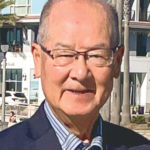This year marks the 64th anniversary of March 16, 1958, when second Soka Gakkai President Josei Toda passed the baton of achieving kosen-rufu to the youth. At his inauguration as Soka Gakkai president on May 3, 1951, Mr. Toda vowed to take the organization’s membership from 3,000 to 750,000 households. Many assumed that he meant 75,000, so this grand declaration was not printed in the Seikyo Shimbun, the Soka Gakkai’s newspaper. The young Daisaku Ikeda, however, took President Toda at his word, and dedicated himself to achieving the goal of 750,000 households, which was accomplished in December 1957. Ikeda Sensei wrote the following about the ceremony:
March 16 was a ceremony to eternally honor and pay tribute to the selfless spirit of Mr. Toda, who had lived in complete accord with [the] words of [Nichiren] Daishonin, and to pass that legacy on to the next generation. (March 2018 Living Buddhism, p. 23)
Living Buddhism met with Frank Nakabayashi, one of the 6,000 youth who attended the March 16 ceremony.
Living Buddhism: We understand you participated in the youth meeting on March 16, 1958. Can you tell us about that time?
 Frank Nakabayashi: My family began practicing Buddhism in 1948. Because the organization was small, we had many occasions to meet with Toda Sensei. We visited him before I entered high school, and he told me: “Wow, high school already? My, you’ve grown up!”
Frank Nakabayashi: My family began practicing Buddhism in 1948. Because the organization was small, we had many occasions to meet with Toda Sensei. We visited him before I entered high school, and he told me: “Wow, high school already? My, you’ve grown up!”
After the Soka Gakkai reached President Toda’s membership goal of 750,000 households, commemorative events were held throughout March at Taiseki-ji temple, outside Tokyo. I joined the Traffic Control Group (forerunner to the Soka Group), a young men’s behind-the-scenes training group. I supported members traveling back and forth by train and bus from Tokyo.
The March 16 ceremony was announced on March 11. Many of us didn’t have telephones, so the young men’s division formed a messenger corps that traveled on motorcycles to inform us.
March 16 happened to be my high school graduation ceremony, so I initially declined, but my mother stepped in and said that I should go. Without her support, I wouldn’t have attended.
I arrived early in the morning and supported the movement. I noticed a field with steam rising, and later learned that’s where men’s division members were cooking the pork soup for 6,000 youth.
The ceremony started around noon. I remember Mr. Toda approaching the microphone, struggling to stand. Like a lion’s roar, he said, “The Soka Gakkai is the king of the religious world. Youth must carry on the mission of kosen-rufu!” When the ceremony was over, several young men carried President Toda on a litter, led by the young Daisaku Ikeda.
I was struck by Ikeda Sensei’s serious determination to support President Toda. During that procession, I made a vow to dedicate my life to kosen-rufu.
How did your life develop after March 16?
Frank: After making a vow for kosen-rufu that day, I went to college and became active in the student division.
In my third year of college, Sensei unexpectedly stepped into one of our student division meetings. There were 11 or 12 of us. He greeted us and asked if we were hungry. Of course, we said, “Yes!” He treated all of us to ramen noodles. As we were eating, he asked each of us what we wanted to achieve in the next 10 years. I said, “I want to participate in American kosen-rufu.” After we all shared our dreams, he said, “Keep that dream for the rest of your life.”
After graduating, I moved to Canada and eventually the United States as an engineer. I have now been striving for American kosen-rufu for 56 years.
Over the years, I’ve met Sensei in Japan and welcomed him to America, and each time he reminded me of the day I made that promise to him as a college student. His care for each of his disciples moves me deeply.
After retiring, I determined to use my training in the SGI to support my community. I joined the Huntington Beach Sister City Association to create bonds with other cities around the world. I’ve now been president of the association for six years. We are creating friendship with cities around the world through cultural and educational exchange programs.
What is the spirit of March 16 you want to share with future generations?
Frank: I learned the importance of the bond of mentor and disciple. Seeing Ikeda Sensei and Toda Sensei together, I felt their unshakable unity, and that they could accomplish anything together. I also learned that a true disciple inherits the fighting spirit to achieve kosen-rufu. President Toda created the foundation for kosen-rufu in Japan, Ikeda Sensei created the path for worldwide kosen-rufu. Now it’s time for us and future generations to take that path and make it even wider!
This year, I will turn 82 years old. My main goals are to stay in good health and raise youth in my chapter. The vow I made on March 16 led to a life of complete fulfillment.
Soaring Into the Future
Twenty-nine years ago this month, Ikeda Sensei established the SGI-USA junior high and high school divisions in San Francisco. On that occasion, he said, “I ask that the leaders responsible … nurture these infinitely precious treasures of the future with all your heart.”[1] We sat down with Nirvana Brady, of Oak Park, California, and Sanidhya Goyal, of Cherry Hill, New Jersey, to hear their experiences and dreams.
Living Buddhism: Hi, Nirvana and Sanidhya! Can you tell us about your experience with Buddhism?
 Nirvana Brady: Growing up, it was hard to see the importance of practicing Buddhism, as I was exposed to different beliefs by my parents. Over the past two years, I’ve struggled to see the value of my life. This manifested in an abusive relationship and friends who didn’t cherish me for who I am. I gave Buddhism a try to break the cycle of self-hatred and negative relationships. As I chanted Nam-myoho-renge-kyo consistently and took responsibility in my local SGI district, I developed confidence in myself. I was able to make better friends who reflected the value I had awakened to in myself.
Nirvana Brady: Growing up, it was hard to see the importance of practicing Buddhism, as I was exposed to different beliefs by my parents. Over the past two years, I’ve struggled to see the value of my life. This manifested in an abusive relationship and friends who didn’t cherish me for who I am. I gave Buddhism a try to break the cycle of self-hatred and negative relationships. As I chanted Nam-myoho-renge-kyo consistently and took responsibility in my local SGI district, I developed confidence in myself. I was able to make better friends who reflected the value I had awakened to in myself.
 Sanidhya Goyal: My parents joined the SGI-USA when I was in third grade, living in Connecticut. At the time, I had no idea what they were doing, but I chanted Nam-myoho-renge-kyo when I had time and went to meetings with them. The more I participated in meetings, the more the practice made sense. I was fascinated by the journey Buddhism took from Shakyamuni Buddha until today.
Sanidhya Goyal: My parents joined the SGI-USA when I was in third grade, living in Connecticut. At the time, I had no idea what they were doing, but I chanted Nam-myoho-renge-kyo when I had time and went to meetings with them. The more I participated in meetings, the more the practice made sense. I was fascinated by the journey Buddhism took from Shakyamuni Buddha until today.
A few years later, we moved to Cherry Hill, New Jersey, where I visited an SGI center for the first time. I was blown away by meeting so many members. Everyone was gearing up for the 50K Lions of Justice Festival, and I made really good friends in the SGI during that time. Observing the 50K movement made me realize how important our kosen-rufu activities are to transform society.
What benefit have you seen from your practice?
Sanidhya: Two major challenges I faced with the COVID-19 pandemic were making friends and keeping my grades up. I began chanting more each day, which gave me clarity and energy to fight for my goals. Making friends never came easy to me, especially because we had moved six times during elementary and middle school. Through chanting, however, I made a goal that I would get a new person’s phone number every week. Striving to achieve this helped me gain confidence to talk to new people, and I’ve made so many connections. I’ve also kept my self-motivation strong to study, especially during our periods of virtual learning.
What role have future division activities played in your faith?
Nirvana: These activities meant a lot to me, especially as a kid. I enjoyed performing for meetings and festivals, like doing the fan dance and taiko drums. My favorite activity was the junior high and high school conference at Soka University of America. There, more than 200 kids my age would gather from across the country, and we even had international guests. I remember hearing one experience from a member about how his father abused him, but through his practice, he transformed the relationship and eventually led his father to Buddhism. It hit me that with this practice any situation can be transformed.
What are some of your dreams?
Sanidhya: My goal is to become an aerospace engineer. I’m fascinated by the secrets of the universe and want to contribute to new discoveries and empower humanity to understand life on a deeper level.
Nirvana: I want to go to Soka University of America to study international affairs. I want to teach around the world and experience education in different cultures. I also want to start a nonprofit that brings agriculture to nursing homes, homeless shelters and low-income neighborhoods. I feel that access to nutritious food plays a foundational role in improving people’s physical and mental quality of life. Lastly, I want to write a book about being raised in three different faiths: Buddhism, Judaism and Christianity. I want to help end religious conflict, because I believe we are all entities of the Mystic Law and should work together and support each other in solving global issues.
What is one of Ikeda Sensei’s writings that has stuck with you?
Nirvana: I love what Sensei says about when we feel betrayed by a friend, and how they hurt others because they are hurting inside.[2] I took away that if you help someone who is hurting others, they will be nicer to other people in the future. Chanting for others’ happiness and alleviating their pain creates a ripple effect of compassion.
Through my practice, I’ve learned that I don’t need anyone to give me happiness. The key is to develop happiness within, and based on that strong inner core, I can build strong, healthy friendships.
Sanidhya: I see the SGI as a judgment-free zone. People will always be there to pick you up if you’re feeling down. I have so many peers who are constantly down on themselves because of what others think of them. Sensei has taught me that I’m a Buddha and that I need to advance toward my mission regardless of what others think. I often go back to his guidance about how it’s OK if we can’t keep our determinations but that the key is to continue renewing them, even if it’s every three days![3]
You are reading {{ meterCount }} of {{ meterMax }} free premium articles

